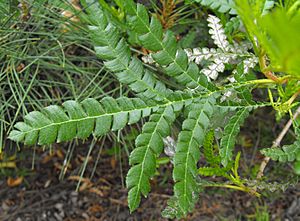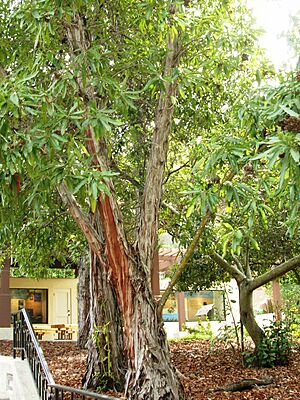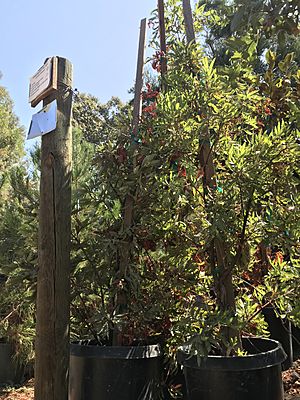Catalina ironwood facts for kids
Quick facts for kids Catalina ironwood |
|
|---|---|
 |
|
| Lyonothamnus floribundus subsp. aspleniifolius leaf | |
| Scientific classification | |
| Genus: |
Lyonothamnus
|
| Species: |
floribundus
|
| Subspecies | |
|
|
Lyonothamnus is a special type of tree in the rose family. It has only one living species, called Lyonothamnus floribundus. People often call it the Catalina ironwood. This tree has two main types, or subspecies: L. f. ssp. aspleniifolius and L. f. ssp. floribundus.
Contents
What is Catalina Ironwood?
The Catalina ironwood tree is found only on the California Channel Islands. It grows in rocky areas near the coast. You can find it in chaparral and oak forests.
How the Tree Looks
This tree can grow up to 15 meters (about 50 feet) tall. It has bark that peels off in reddish-gray or brown strips. Its leaves stay green all year. They are shiny and dark green on top, with lighter undersides.
The two different types of this tree have different leaf shapes. The flowers are white and grow in clusters. They have many short, whiskery parts called stamens. After flowering, the tree produces small, hard fruits. Each fruit is made of two parts.
Clones and Groves
In nature, these trees often grow in distinct groups called groves. Scientists have found that each grove is like a giant family of clones. This means all the trees in one grove are genetically identical. They are like many copies of one original tree.
Each "clone" or "genet" is a group of trees that are exactly alike. A single clone can have dozens or even hundreds of tree trunks. Later studies using DNA also confirmed that these trees are clones.
Why Conservation is Important
Because these island ironwoods are clones, there are fewer different genetic individuals on each island. This means there isn't much genetic variety. Isolated clones in tough, rocky areas can make it hard for trees to cross-pollinate. This might be why they don't produce many good seeds in nature.
It is very important to protect the unique genetic makeup of each island's Lyonothamnus floribundus population. People who manage the islands must be careful. They should not bring Lyonothamnus trees from other islands or from nurseries on the mainland. This helps keep the native trees pure. For example, two types of L. f. ssp. aspleniifolius have been brought to Santa Catalina Island. This could be a problem for the native L.f. ssp. floribundus trees there.
Where Did This Tree Come From?
Lyonothamnus is now found only on a few islands. But scientists have found fossils that show this tree genus used to have many more species. Most of them are now extinct. These ancient trees once grew on the mainland in the southwestern United States.
Two Types of Catalina Ironwood
There are two main subspecies of Lyonothamnus floribundus. They have different leaf shapes and grow on different islands.
- ssp. aspleniifolius is found only on Santa Cruz, Santa Rosa, and San Clemente islands. Its leaves look like fern fronds, with many small leaflets.
- ssp. floribundus is found only on Santa Catalina Island. Its leaves are simpler, long, and narrow. Sometimes they have irregular bumps at the base. Young seedlings often have more complex leaves, but they become simpler as the tree grows.
Growing Catalina Ironwood
The Lyonothamnus ssp. aspleniifolius tree is popular in plant nurseries. It is used in landscape design for gardens and public spaces. It's a great choice for drought-tolerant gardens because it doesn't need much water. It's also used in California native plant gardens and wildlife gardens.



